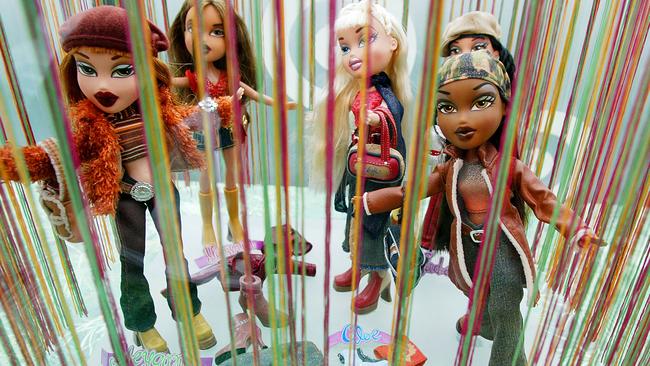When Mattel and MGA went to war over Barbie
When Mattel heard that the trendy Bratz dolls were the brainchild of one of its former designers, it went nuclear.

Like Condoleezza Rice, Ivanka Trump and Michelle Obama, Orly Lobel played with Barbie dolls when she was growing up.
“Fortunately,” writes the San Diego law professor in her new book, “I was also encouraged to challenge the distorted realities of Barbie’s world”.
No toy has been deconstructed so thoroughly as Mattel’s iconic plastic doll.
But Lobel’s You Don’t Own Me is something different. The world that she explores is not a dollhouse but a courthouse.
Her brisk and engaging book chronicles the decade-long copyright clash between Mattel and MGA Entertainment, an upstart rival that had a mega-hit with its “Bratz” doll line but was nearly obliterated by Mattel’s scorched-earth legal offensive.
Words like “war” are overused in stories about lawsuits, but if ever there was an example of a civil dispute meriting military metaphors, it is Mattel vs MGA. According to Lobel, the combined legal expenses of the battle went north of $US600 million ($777m).
The idea for Barbie herself was far from original. The doll’s story starts in the 1950s, when a chain-smoking Jewish businesswoman named Ruth Handler was holidaying in Switzerland and encountered Bild Lilli, a purse-lipped fashionista doll based on a fictional, gold-digging prostitute in a German comic strip.
Handler (who died in 2002) spirited the doll out of Europe and recruited an ex-missile engineer, Jack Ryan, to design an Americanised, child-friendly version of Lilli with less sensual lips, wider eyes and a less precise anatomy that preserved the doll’s impossible proportions.
For marketing, Handler turned to psychologist Ernest Dichter, who devised a way to sell sex appeal to kids by pitching Barbie to parents as a role model of grace, poise and beauty. Handler hired a Japanese firm to forge the original Barbie, launching the 11-inch (28cm) bombshell at a New York toy fair in 1959.
Barbie’s birth was followed by a nasty custody battle. The era’s reigning toy king, Louis Marx, had the licensing rights to the German doll in the American market and suspected that Handler’s knockout was a knock-off.
He and the German patent holder sued in 1961. Handler countersued with an anti-competition claim, scored a cheap settlement, and then bought Lilli’s rights for $US21,000, according to Lobel.
By 1965, Mattel was a Fortune 500 company. By 2000, more than 1 billion Barbies had been sold.
Mattel became not just a toy company but also a reputation manager, shielding Barbie from the sordid deeds of her creators. Lobel alludes, for instance, to orgies at Jack Ryan’s Bel Air sex castle in Los Angeles and the securities fraud charges levelled against Handler in 1978.
But they didn’t tarnish Barbie’s innocence. As Barbie aged, Mattel also grew increasingly protective of her copyrights, adopting a deterrence strategy that Lobel describes as “litigate to death”.
When the pop song Barbie Girl became a hit in the late 1990s, Mattel sued (without success) to keep it off the airwaves. And a federal judge deemed “groundless” Mattel’s suit against a Utah artist and his photos of nude Barbies imperilled by kitchen appliances. But Mattel did persuade a Mexican court to ban a short film depicting Ken, Barbie’s male counterpart, as a cheater and Barbie as a gloomy, lesbian housewife.
While Mattel churned out lawsuits, plucky MGA and its Iranian Jewish chief executive shook up the toy industry in 2001 with its Bratz dolls: cute, wide-eyed, large-headed new girls on the block, with ethnic identities and a sexualised, urban style that made Barbie seem like an outdated Sandra Dee. Bratz dolls drove parents crazy, but kids were crazy for them.
When word got out that the dolls were the brainchild of Carter Bryant, a former Mattel designer who had defected to MGA, Mattel executives went nuclear. They alleged that Mattel was the owner of Bryant’s prototype doll-design drawings and the “sculpt” on which the Bratz dolls were based. Mattel sought monetary damages of close to $US2 billion.
Bryant said that the idea of a bratty, sassier doll came to him in 1998 while he was driving by a high school in southwest Missouri, where he was living with his parents during a break from working at Mattel.
“The teenage girls Carter spotted coming out of the gates of Kickapoo High School were sassy, hip and vibrant,” Lobel writes. “They showed midriff and defied typecasting.”
Later, Bryant hid his business arrangement with MGA from Mattel, which seized on this secrecy to paint him as a disloyal sneak. It looked as if Bratz dolls were goners when, in 2008, a federal jury found MGA liable for infringing Mattel’s copyrights. MGA appealed and found a crucial ally in the bawdy and brilliant Alex Kozinski, then a judge on the Ninth US Circuit Court of Appeals.
The libertarian Judge Kozinski “was rather comfortable with contractual expansion over employee creativity, provided it was drafted diligently”, writes Lobel, but “he was far more suspicious of wholesale copyright protection”.
In his 2010 opinion reversing the verdict against MGA, Judge Kozinski wrote that, whatever Bryant’s employment agreement with Mattel, the company “can’t claim a monopoly over fashion dolls with a bratty look or attitude, or dolls sporting trendy clothing — these are all unprotectable ideas”.
MGA went on to win a retrial, then grabbed the upper hand by exposing how dirty Mattel had played, claiming (in still pending litigation) that Mattel used phony IDs and business cards to infiltrate MGA’s private showrooms. Separately, Lobel says, Mattel spied on its employees’ emails to ferret out disloyalty.
As for the broad lesson of this nasty episode, Lobel contends that the Mattel vs MGA case underscores concerns about corporate control over individual creativity.
Perhaps. But the book is more compelling as a cautionary tale for dominant companies at the top of the food chain: don’t lean too heavily on lawsuits to deter smaller rivals rather than investing in original, fresh ideas.
Today’s Barbies have more realistic body shapes as well as ethnic diversity, but sagging sales. There’s a line of Barbie “career dolls” featuring the doll as a chef, doctor, pilot and US president.
One profession notably absent is lawyer. It’s an admirable profession, but you can’t blame Barbie if she’s had enough of lawyers.
The Wall Street Journal


